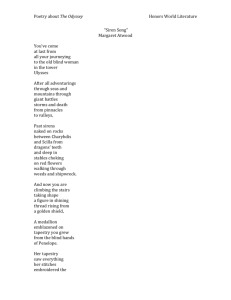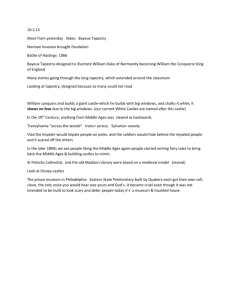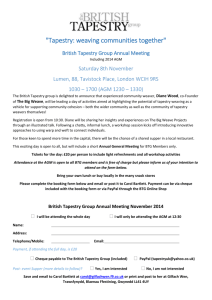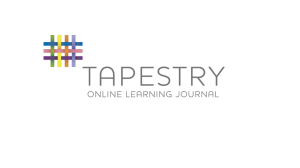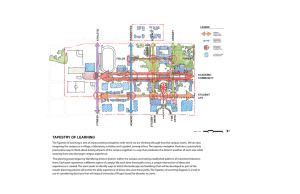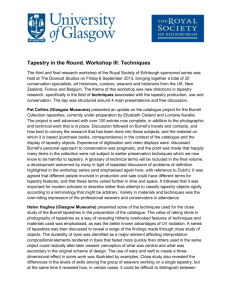Tapestry in the Round. Workshop II: People
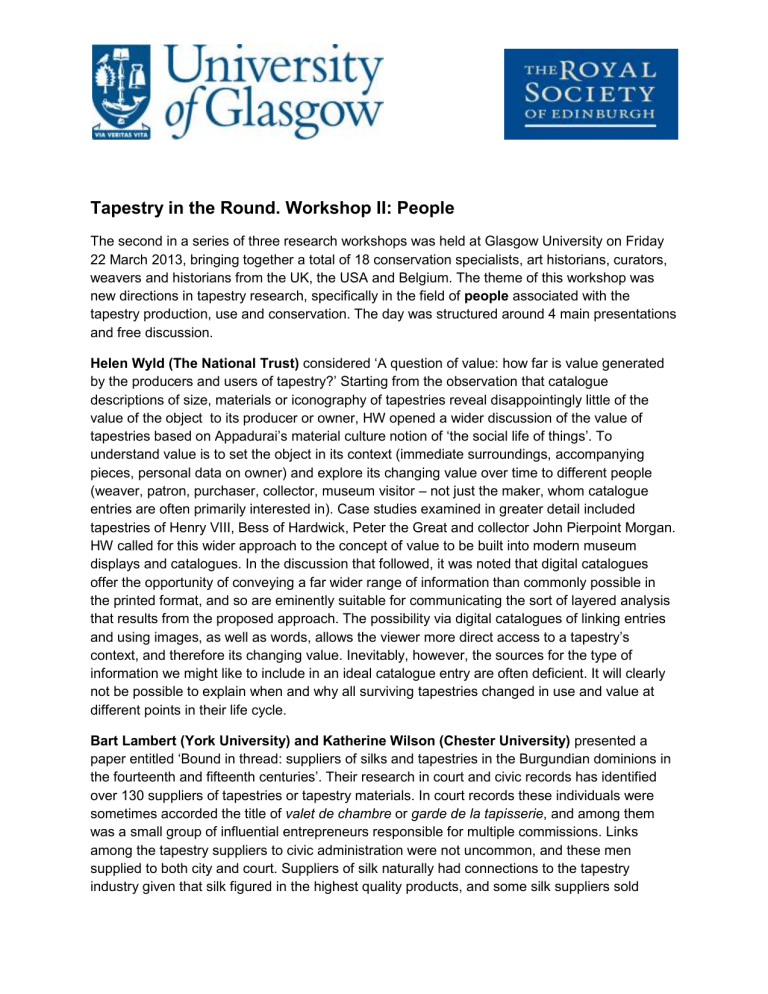
Tapestry in the Round. Workshop II: People
The second in a series of three research workshops was held at Glasgow University on Friday
22 March 2013, bringing together a total of 18 conservation specialists, art historians, curators, weavers and historians from the UK, the USA and Belgium. The theme of this workshop was new directions in tapestry research, specifically in the field of people associated with the tapestry production, use and conservation. The day was structured around 4 main presentations and free discussion.
Helen Wyld (The National Trust) considered ‘A question of value: how far is value generated by the producers and users of tapestry?’ Starting from the observation that catalogue descriptions of size, materials or iconography of tapestries reveal disappointingly little of the value of the object to its producer or owner, HW opened a wider discussion of the value of tapestries based on Appadurai’s material culture notion of ‘the social life of things’. To understand value is to set the object in its context (immediate surroundings, accompanying pieces, personal data on owner) and explore its changing value over time to different people
(weaver, patron, purchaser, collector, museum visitor – not just the maker, whom catalogue entries are often primarily interested in). Case studies examined in greater detail included tapestries of Henry VIII, Bess of Hardwick, Peter the Great and collector John Pierpoint Morgan.
HW called for this wider approach to the concept of value to be built into modern museum displays and catalogues. In the discussion that followed, it was noted that digital catalogues offer the opportunity of conveying a far wider range of information than commonly possible in the printed format, and so are eminently suitable for communicating the sort of layered analysis that results from the proposed approach. The possibility via digital catalogues of linking entries and using images, as well as words, allows the viewer more direct access to a tapestry’s context, and therefore its changing value. Inevitably, however, the sources for the type of information we might like to include in an ideal catalogue entry are often deficient. It will clearly not be possible to explain when and why all surviving tapestries changed in use and value at different points in their life cycle.
Bart Lambert (York University) and Katherine Wilson (Chester University) presented a paper entitled ‘Bound in thread: suppliers of silks and tapestries in the Burgundian dominions in the fourteenth and fifteenth centuries’. Their research in court and civic records has identified over 130 suppliers of tapestries or tapestry materials. In court records these individuals were sometimes accorded the title of valet de chambre or garde de la tapisserie , and among them was a small group of influential entrepreneurs responsible for multiple commissions. Links among the tapestry suppliers to civic administration were not uncommon, and these men supplied to both city and court. Suppliers of silk naturally had connections to the tapestry industry given that silk figured in the highest quality products, and some silk suppliers sold
tapestries from the Netherlands to markers further afield, especially Italy. But in other respects the silk suppliers were a different breed. Silk as a commodity was closely connected to the business of international finance and the lending of money to the court and cities of the Low
Countries. Silk suppliers were a smaller, more influential group consisting mainly of Italian merchants, mostly in fact from Lucca, foremost among them men like Arnolfini and Portinari.
Both tapestry and silk suppliers tended to take financial risks on a significant scale, however, and sought to spread risk through family alliances and intermarriage. The relationship of both groups to the wider context of people involved in tapestry production then followed, with particular emphasis on the guild of dyers and on the shadowy figures of tapestry entrepreneurs.
The argument forwarded in the first workshop by Peter Stabel, namely that tapestry production was a small-scale industry located at the margins of other activities, found some confirmation in the fact that there was relatively little overlap between the tapestry merchants and silk suppliers.
Klara Alen (Leuven University) presented a paper on the current Leuven project entitled
‘Mapping the Antwerp-Brussels-Oudenarde tapestry complex’, and she also presented the work of her colleague Astrid Slagten on case studies from Brussels. Much tapestry research has focused on makers and buyers, and less on the larger group of producers. The project of which both KA and AS are members takes seventeenth-century evidence in the form of published and unpublished archival materials from one of Europe’s major centres of tapestry production. Using social network analysis, the project is particularly concerned to demonstrate how the very considerable financial risks involved in tapestry production (see above) were spread across producers. Among the many tapestry workers identified thus far is Hendrik de Puttere from
Brussels, whose signature survives on two tapestries. His story reveals family networks operating in a local context sharing resources (eg. buildings), but also serving as the basis for the dissemination of tapestry production further afield (England). It also reveals how difficult it was to break into existing social networks of production when coming from the outside
(marriage was one way of getting round the obstacle, and the project is also revealing the importance of godparenting relationships in the social networks involved in tapestry production).
The wealth of sources (parish and guild records, legal instruments, municipal documents etc.) for the seventeenth century stands in sharp contrast to the paucity of sources for earlier periods, notably the fifteenth century.
The final discussion session of the workshop focused on the difficulties of bringing forth the stories of people involved in tapestry production in particular. It was noted by several participants that modern tapestry production and the careful presentation of the technical features of existing tapestries can be used to reveal the skills and processes associated with tapestry producers of past times. Time-lapse photography of modern tapestry production and close camera work on existing tapestries enable modern viewers to undertand what producing tapestries entailed.
List of participants
Francesca Baseby (Edinburgh University/Dovecot Studios), Barbara Caen (The Frick
Collection), Jonathan Cleaver (Dovecot Studios), Rosamund Garrett (Courtauld Institute), Liz
Hancock (Glasgow University), Helen Murdina Hughes (Glasgow Museums), Bart Lambert
(York University), Frances Lennard (Glasgow University), Ksynia Marko (The National Trust),
Jamie Mulherron (Independent scholar), Caron Penney (West Dean Tapestry Studio), Anita
Quye (Glasgow University), Sally Rush (Glasgow University), Astrid Slegten (Leuven
University), Graeme Small (Durham University), Laura Weigert (Rutgers University), Katherine
Wilson (Chester University), Helen Wyld (National Trust).

